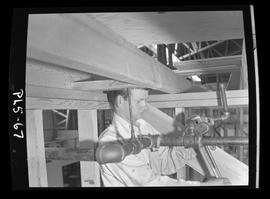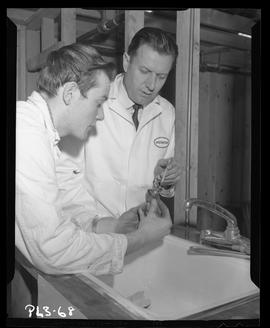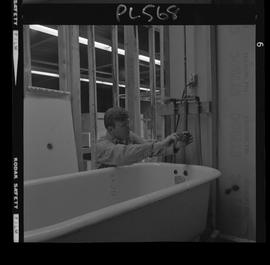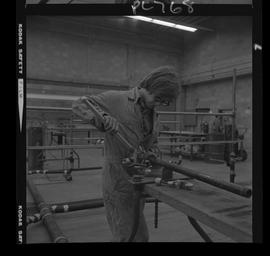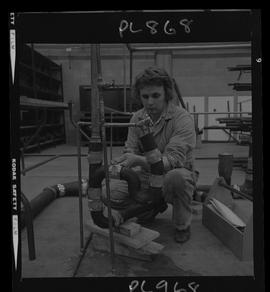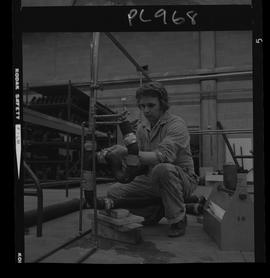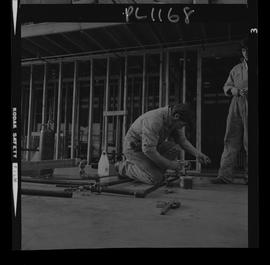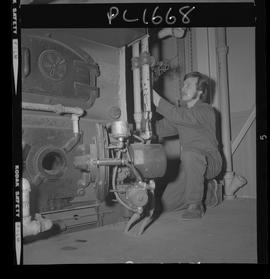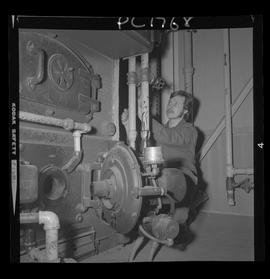Identity area
Reference code
Title
Date(s)
- 1952- (Creation)
Level of description
Collection
Extent and medium
ca. 300,000 photographs
Context area
Name of creator
Administrative history
The BCIT Marketing and Communications Department began in 1974 in conjunction with BCIT’s first year as an autonomous entity under a Board of Governors rather than under the direct control of the British Columbia Department of Education. BCIT Principal Gordon A. Thom created three new Executive Directorships in this year: Technology and Education; Administration; and Personnel, Information Services and Student Services. The Marketing and Communications Department started as an area of service provided under the Executive Director, Personnel, Student Services and Information Services. It was known as Information Services although the term “communications” was used to describe its duties and responsibilities. The first Director of Information Services was recruited in 1975 and was responsible for information dissemination among BCIT staff, students, faculty and the public. Ensuring relevant parties were aware of decisions and developments at BCIT and providing a mechanism for feedback. In 1975 the Director of Information Services began work on an information policy for BCIT and revived the newsletter “Developments” which enhanced internal BCIT communications.
In 1977 Information Services was moved under the Human Resources Division. During this time Information Services continued its broad-based program of internal and external communications. The department served as liaison between federal and provincial governments on the residence project, participated in presentations on Bill 82, and began work on revitalizing the Alumni Association.
In 1979 Information Services, still under Vice President Human Resources, underwent a name change and was known as the Public Relations department.
After the merger with the Pacific Vocational Institute in 1985 the department was again moved and given a name change. Now known as Community Relations, the Director of Community Relations/Development reported to the Vice President of Student Services and Educational Support.
Name of creator
Administrative history
On April 1st, 1978, Pacific Vocational Institute (PVI) assumed its official status as an independent crown corporation. PVI was to function under one board of industrial representatives who would maintain direct financial control, planning and operation of the institution.
Appointed by cabinet, the following individuals were named to the board of governors:
Mr. Leslie R. Redford, Frank Redder, Don Fearey, Jake Wyman, Donald Doyle, E. A. Killough, T. Wyman Trineer, T. Stuart Mathieson, and Nadine Sherwin.
The PVI Board of Governors had three senior officers:
L.R. Redford 1978-1981
T.W. Trineer 1981-1984
F. Sondergaard 1985-1986
By 1983, the school registered about 23,000 students a year. Classes consisted of accounting, aviation, business administration, clerical, marketing, construction, building service, painting and decorating, food training, graphics, photography, industrial safety, instructor training, personal development, mechanical, piping, plumbing and gas, steel, welding, drafting, electrical, industrial electronics for electricians, industrial mathematics, non-destructive testing, and refrigeration.
Henry Justesen was the sole Principal of PVI, 1978-1986.
Name of creator
Administrative history
The British Columbia Institute of Technology (BCIT) officially opened October 4, 1964. Areas of study available were: Engineering, Health and Business.
On January 17th, 1958, the Minister of Education for the Province of British Columbia, the Hon. L. R. Petersen announced the appointment of the Royal Commission on Education for the Province of British Columbia for the “purpose of reviewing and assessing the educational system with he aim of improving its effectiveness in the light of world conditions and providing guidance for its future development.” Concurrent with the Commissions inquiry the Provincial Curriculum Advisory Board of the Department of Education appointed a committee directed by Mr. D. E. Bridge of the Vocational Training Branch of the Department of Labour, Ottawa to survey “The Need for Advanced Technical and Vocational Training in British Columbia.” As a result of the Royal Commission on Education, the Bridge Report and financial assistance from the Federal Government, an Advisory Council was formed early 1961 to begin planning what would become the British Columbia Institute of Technology. Dr. J. English, Deputy Minister and Superintendent of Education was appointed chairman and Mr. J. S. White, Director of Technical and Vocational Education, vice-chair.
Until 1974 BCIT was directly controlled and funded by the B.C. Department of Education, in partnership with an Advisory Council chosen from business and industry. The council appointed the Principal of BCIT as the Chief Executive Officer of the Institute. Two Vice-Principals were responsible for Administration and the growing Extension Division. The three divisions of Engineering, Business and Health were managed by three Directors reporting directly to the Principal. The Council formed seventeen advisory committees which met at least twice a year and advised Technology Heads at BCIT about the effectiveness of the programs being taught, opportunities for employment and updates in the industry. Recommendations went through the Principal who carried them to the main Advisory Council. In 1963, the Department of Education took a radical departure from existing government policy and allowed the BC Civil Service Commission to delegate responsibility for selecting teaching staff to the Institute, via the Advisory Council and Principal.
In 1972, the Minister of Education established a task force to recommend future directions for BCIT. A more autonomous relationship developed between the provincial government and BCIT with the passage of the British Columbia Institute of Technology Act on July 4, 1974. The Act established a new system of governance for BCIT under a fifteen–person Board of Governors. Under Section 11 (3) of the BCIT Act the Principal was required to submit an Annual Report to the Board of Governors for the educational year. The position of Principal was expanded to encompass linking functions both between the Board of Governors and BCIT, and between BCIT and the external community. The Principal assumed the responsibility of implementing Board policy and administering the budget; she also served as the chief means of mobilizing the institute’s resources in recognizing and clarifying issues and expediting decision making. At the same time, three Executive Director positions were created in the areas of Technical Education; Administration; and Personnel and Information Services and Student Services, in order that BCIT could effectively carry on day-to-day operations while implementing a variety of administrative systems. With the Directors of the five Educational Divisions, the Bursar, the Registrar, and the Coordinator of Planning Services, the Executive Directors were members of an Executive Committee, a consultative body which advised the Principal and served as a channel of communication between the Chief Executive Officer and the institutes staff, students and faculty.
In 1978 the Boards of the Pacific Vocational Institute (PVI) and BCIT established a Joint Boards Committee, enhancing the relationship of the neighbours and providing a forum for cooperation between the institutions in matters of mutual interest. On May 31, 1985, the Honourable John H. Heinrich, then Minister of Education announced the decision to amalgamate the Pacific Vocational Institute (PVI) and the British Columbia Institute of Technology. The merger culminated in a new organizational structure, a mission statement and a set of corporate objectives for BCIT. The expanded mandate for the new institution included:
• A centre of excellence for the trades
• The development of new technology programs
• The development of post diploma programs
• The development of bridging programs from trades to technology
The official merger took place on April 1, 1986. In July 1985, the President and the Board of Governors appointed Drug Svetic Vice President, Education; Duncan McPherson Vice President, Finance; Len McNeely Vice President, Administration; and Peter Jones Vice President, Student Services and Educational Support. The reorganization of BCIT’s educational division resulted five schools, adding an Executive Director of Trades Training and the introduction of an associate dean structure.
In 2004, BCIT's governing legislation became the College and Institute Act, RSBC 1996, ch. 5 (2). Under this Act, the President is defined as BCIT's Chief Executive Office, with the duty to “supervise and direct subject to bylaws, the instructional, administrative and other staff of the institution and exercise powers and perform duties assigned to the president by the board.” The President is to report to the Board annually on the progress of the Institute, make recommendations, and advise the Board on all matters concerning the operation of the Institute.
Name of creator
Administrative history
In 1960 the British Columbia Vocational School for trades training opened in BC in 1960. The British Columbia Premier at the time was Hon. W.A.C. Bennett, he gave the address at the opening ceremonies.
In May 1961, the provincial government provided funds for further expansion. The second phase of building was completed in late 1963 allowing those classes still remaining at the PNE to move in. In 1967, increases in enrollment lead to the creation of the BCVS Burnaby Lake Division. Located in rented facilities in the Pit Par Buildings at Winston St in Burnaby, the Burnaby Lake Division included Electrical, Ironworking, Boilermaking and Appliance Servicing training. In September 1967, Machinists’ Training was added to the BCVS Burnaby Campus.
BCVS initially offered fourteen courses which ranged from six months for most trades, to two years for aeronautics. Classes were divided into pre- apprenticeship, to prepare the student for employment as an apprentice; apprenticeship to give indentured apprentices further training; pre-employment to give individuals entry into skilled work areas of industry; and upgrading to provide training in special areas for journeymen already working in the field.
On July 9, 1976 a directive was issued by the Ministry of Education to the Superintendent of Post-secondary Programs, Henry Justesen to prepare reports and recommendations on vocational training in British Columbia. The subsequent recommendations, combined with recommendations from the Provincial Government’s Commission on Vocational –Technical and Trades Training in British Columbia, headed by Dean Goard Sr., recommended a new vocational institute be formed. Major components of the proposed institute would be the British Columbia Vocational School in Burnaby and the Haney Educational in Maple Ridge. Dr. Walter Hardwick, Deputy Minister of Education, formally named Henry Justesen as Chief Executive Officer of the new institute.
In March 1977 a five member British Columbia Vocational School Advisory Board was appointed by Education Minister Dr, Pat McGreer, to oversee the development of the new institute. Mr. Leslie R. Redford was named as Chairman of the Advisory Board. Other members included Frank Redder, Don Fearey, Jake Wyman, and Donald Doyle. The Board met once a month. In anticipation of the future merger, the Haney Educational Centre was renamed the “Pacific Vocational Institute - Maple Ridge Campus” in May 1977. On September 27, 1977, Bill 82 – The Colleges and Provincial Institutes Act was given Royal Assent by the British Columbia legislature. Under Part III of the Act, the Lieutenant Governor in Council could now designate Provincial Institutes.
Principals of BCVS were:
Colonel John W. Inglis 1960-1966
Mr. Lorne Smith 1966- 1976
Mr. J. Cooper 1976-1978
Archival history
The archival history of these photographs is varied this is an artificial collection of photographs deemed historical to the institute. Some of the photographs were inherited from predecessor institutes. The majority of the photographs were created by BCIT Marketing and Communications. However, not all are. In anticipation of BCIT's 50th anniversary in 2014/2015 several digitization projects were undertaken by the BCIT Archivist from 2011-2013. This work to further share the collection online continues.
Immediate source of acquisition or transfer
Content and structure area
Scope and content
Collection includes more than 250, 000 photographs dating from the founding of the Institute, in 1964, to the present day. They offer a visual record of BCIT's growth and development, our relationships with industry and the community, and include images of student life, construction of the campuses and campus events.
Appraisal, destruction and scheduling
Accruals
Further accruals are expected.
System of arrangement
As this is an artificial 'collection' of photographs most of the materials are simply described at the item level. Collection contains four series:
- C23-s01 BCIT contact sheets series 1 (originally created for internal access only)
- C23-s02 Photographs taken by BCIT staff photographers ca.1994-2003 series 2
- C23-s03 School photographs A through Z - contact prints 1955-1971 series 3
*C23-s04 School photographs A through Z - prints and related materials 1952-1971 series 4
Conditions of access and use area
Conditions governing access
These images are provided for research and reference use only. Please contact the BCIT Archives for permission to publish, copy or otherwise use this material.
Conditions governing reproduction
Language of material
Script of material
Language and script notes
Physical characteristics and technical requirements
Finding aids
Allied materials area
Existence and location of originals
Existence and location of copies
Related units of description
Notes area
Note
Access to some items in this collection are restricted. See individual item description for details.
Alternative identifier(s)
Access points
Subject access points
Place access points
Name access points
Genre access points
Description control area
Description identifier
Rules and/or conventions used
Status
Level of detail
Dates of creation revision deletion
C. McLellan, created 2015-07-28
Language(s)
Script(s)
Sources
Digital object metadata
Filename
Cover-Image_a001036a.tif
Latitude
Longitude
Media type
Image
Mime-type
image/tiff

![Aerial Photograph of BCIT and BCVS. Vertical Air photo. Burnaby Campus [1 of 2 photographs]](/uploads/r/null/6/c/e/6cea33db01be1c8204ae00ef9bd724b0047f0bd13ca88ee5c77939c788a638a5/a000001_142.jpg)
![Aerial Photograph of BCIT and BCVS. Vertical Air photo. Burnaby Campus [2 of 2 photographs]](/uploads/r/null/3/0/b/30be8d85d9028ae241c03e8533080e34dfc09d2030848f271b1381f8efa3348c/a000002_142.jpg)




